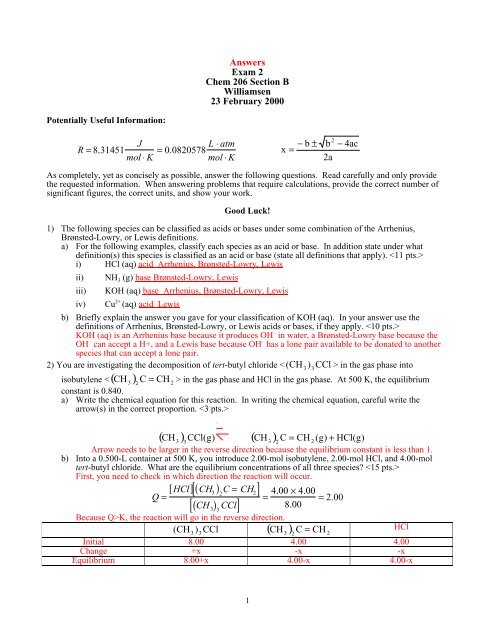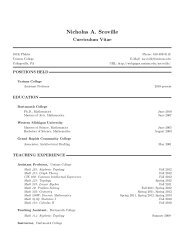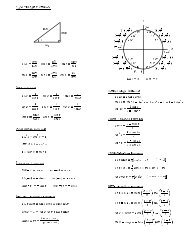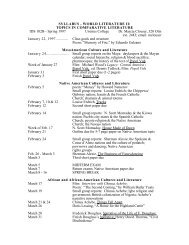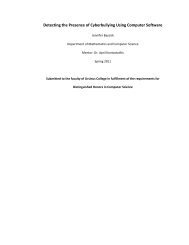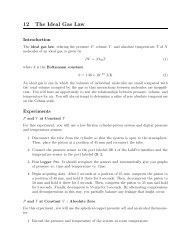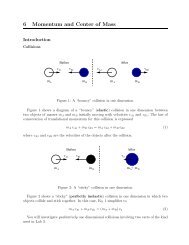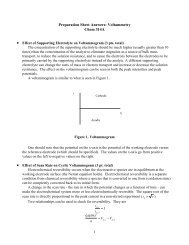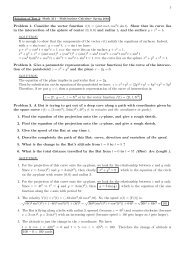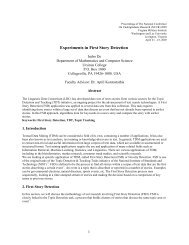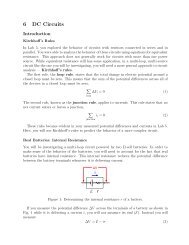Chem 206 Exam 2 Answers
Chem 206 Exam 2 Answers
Chem 206 Exam 2 Answers
You also want an ePaper? Increase the reach of your titles
YUMPU automatically turns print PDFs into web optimized ePapers that Google loves.
<strong>Answers</strong><br />
<strong>Exam</strong> 2<br />
<strong>Chem</strong> <strong>206</strong> Section B<br />
Williamsen<br />
23 February 2000<br />
Potentially Useful Information:<br />
J<br />
R = 8.31451<br />
mol ⋅ K<br />
= 0.0820578<br />
L ⋅ atm<br />
mol ⋅ K<br />
x =<br />
− b ±<br />
b<br />
2a<br />
2 −<br />
4ac<br />
As completely, yet as concisely as possible, answer the following questions. Read carefully and only provide<br />
the requested information. When answering problems that require calculations, provide the correct number of<br />
significant figures, the correct units, and show your work.<br />
Good Luck!<br />
1) The following species can be classified as acids or bases under some combination of the Arrhenius,<br />
Brønsted-Lowry, or Lewis definitions.<br />
a) For the following examples, classify each species as an acid or base. In addition state under what<br />
definition(s) this species is classified as an acid or base (state all definitions that apply). <br />
i) HCl (aq) acid Arrhenius, Brønsted-Lowry, Lewis<br />
ii)<br />
iii)<br />
iv)<br />
NH 3 (g) base Brønsted-Lowry, Lewis<br />
KOH (aq) base Arrhenius, Brønsted-Lowry, Lewis<br />
Cu 2+ (aq) acid Lewis<br />
b) Briefly explain the answer you gave for your classification of KOH (aq). In your answer use the<br />
definitions of Arrhenius, Brønsted-Lowry, or Lewis acids or bases, if they apply. <br />
KOH (aq) is an Arrhenius base because it produces OH – in water, a Brønsted-Lowry base because the<br />
OH – can accept a H+, and a Lewis base because OH – has a lone pair available to be donated to another<br />
species that can accept a lone pair.<br />
2) You are investigating the decomposition of tert-butyl chloride < ( CH<br />
3<br />
)<br />
3CCl<br />
> in the gas phase into<br />
isobutylene in the gas phase and HCl in the gas phase. At 500 K, the equilibrium<br />
constant is 0.840.<br />
a) Write the chemical equation for this reaction. In writing the chemical equation, careful write the<br />
arrow(s) in the correct proportion. <br />
( CH 3<br />
) 3<br />
CCl(g)<br />
( CH<br />
3<br />
) C = CH<br />
2<br />
(g) + HCl(g)<br />
Arrow needs to be larger in the reverse direction because the equilibrium constant is less than 1.<br />
b) Into a 0.500-L container at 500 K, you introduce 2.00-mol isobutylene, 2.00-mol HCl, and 4.00-mol<br />
tert-butyl chloride. What are the equilibrium concentrations of all three species? <br />
First, you need to check in which direction the reaction will occur.<br />
[<br />
Q = HCl]<br />
[( CH 3<br />
) 2<br />
C = CH 2 ] 4.00 × 4.00<br />
= = 2.00<br />
[( CH 3 ) 3<br />
CCl]<br />
8.00<br />
Because Q>K, the reaction will go in the reverse direction.<br />
( CH<br />
3<br />
)<br />
3CCl<br />
( CH<br />
3) C = CH<br />
2<br />
2<br />
HCl<br />
Initial 8.00 4.00 4.00<br />
Change +x -x -x<br />
Equilibrium 8.00+x 4.00-x 4.00-x<br />
2<br />
1
( 4.00 − x)( 4.00 − x)<br />
( 8.00 + x)<br />
K =<br />
= 0.840<br />
16.0 − 8.00x + x<br />
0.840 =<br />
8.00 + x<br />
x 2 − 8.840x + 9.2 = 0<br />
( )<br />
x = 8.840 ± −8.8402 − 4.00 ×1.00 × 9.2<br />
2.00 ×1.00<br />
2<br />
= 1.2or 7.6<br />
Can't use 7.6, as this will give negative concentrations. Therefore, the equilibrium concentrations are<br />
( CH<br />
3<br />
)<br />
3CCl<br />
( CH<br />
3) C = CH<br />
HCl<br />
2<br />
2<br />
Concentrations 9.2 2.8 2.8<br />
2.8 × 2.8<br />
Check, K = = 0.85<br />
9.2<br />
c) You study the kinetics of both the forward and reverse reactions and determine that both the forward<br />
and reverse reactions occur in a single elementary step. At 500 K you determine that the rate constant<br />
for the reverse reaction is 3.45 M -1 s -1 . At equilibrium what is the rate (not rate constant) for the forward<br />
reaction? <br />
Rate law for the forward reaction is Rate = k<br />
f<br />
[( CH<br />
3)<br />
CCl]<br />
3<br />
k<br />
f<br />
K = so k<br />
k<br />
f<br />
= 0.840 × 3.45 = 2.90 s −1<br />
r<br />
Therefore, the rate is 2.90 s −1 × 9.2 = 27 M ⋅ s −1 . Note: You must use the equilibrium concentration.<br />
Or: Because at equilibrium k f =k r , 3.45 M −1 ⋅ s −1 × 2.8 × 2.8 = 27 M ⋅ s −1<br />
d) After equilibrium is obtained, you add a catalyst and 3.00 additional moles of HCl. What will happen?<br />
<br />
The addition of a catalyst will not change the equilibrium but will only increase the rate at which<br />
equilibrium will be obtained. The addition of HCl will cause the reaction to go to the left (reverse<br />
direction) to relieve the stress (Le Châtlier's Principle)<br />
3) Acid rain is a topic that is often in the news. Even without pollution, however, rain is naturally acidic.<br />
a) What is the reason for the natural acidity of rain water? Briefly explain. Include in your answer the<br />
chemical equation for the species that are in equilibrium to cause the naturally acidic rain. <br />
One of the main constituents of the atmosphere is CO 2 . As rainwater falls to the earth, CO 2 diffuses into<br />
the raindrop to form carbonic acid. Therefore, rainwater has a natural pH of approximately 5.6.<br />
CO<br />
2<br />
(g) + H<br />
2O(l)<br />
H<br />
2CO3(aq)<br />
2
) The [H 3 O + ] for naturally acidic rain is 2.51x10 -6 M. What is the pH? Show your work and write the<br />
correct number of significant figures. <br />
pH ≈ −log[ 2.51 ×10 −6<br />
] ≈ 5.600<br />
c) If you experimentally measured the pH, would your measured value equal the value that you calculated<br />
in part b)? Why or why not? <br />
No. pH is not really defined as the negative log of the concentration of hydrogen cation but as the<br />
negative log of the activity of the hydrogen cation. The activity is a H<br />
+ = [ H +<br />
]f .<br />
3) For each pair of acids, state which acid is strongest. For each comparison briefly explain your answer. For<br />
polyprotic acids (more than one acidic proton), just consider the dissociation of the first proton. <br />
a) HCl (aq) or H 2 S(aq)<br />
HCl. HCl is one of the few strong acids and H 2 S is not. Also, Cl – is more electronegative than S 2– so<br />
the bond is more polar in HCl, and Cl – will be the more stable conjugate base.<br />
b) H 2 SO 3 (aq) or HClO 3 (aq)<br />
HClO 3 . Cl is more electronegative than S. Because there are the same number of O's, the more<br />
electronegative central atom in the anion will make the conjugate base more stable as it can handle the<br />
negative charge better.<br />
c) HF (aq) or HBr (aq)<br />
HBr. One of the strong acids and HF is not. F and Br are both halogens. Because Br is larger than F,<br />
the bond is weaker.<br />
4) You are monitoring the following reaction: HCl (aq) + NaCN(aq)<br />
HCN (aq) + NaCl(aq)<br />
.<br />
a) You add equal concentrations of the species in the reaction pot. In which direction will the reaction<br />
occur. Why? <br />
The reaction will occur in the forward direction. HCl is a stronger acid than HCN, and NaCN is a<br />
stronger base than NaCl. The reaction goes in the direction so that the stronger acid and base react.<br />
b) What are conjugate acid-base pairs in the above reaction? <br />
HCl (acid) and NaCl (conjugate base)<br />
NaCN (base) and HCN (conjugate acid)<br />
6) Briefly explain what the difference is between Q and K. <br />
The method of calculation for both Q and K is the same for both, but a value for Q can be computed at any<br />
time during the reaction, but the value for K only holds at equilibrium.<br />
Last Update: 26 February 2000 EJW<br />
3


